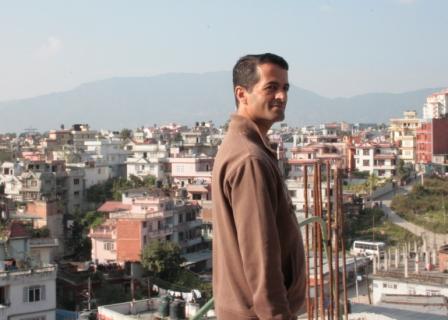Brushing dust and gravel aside with his foot, Sunil Babu Pant pulls a corrugated aluminum door open and walks through it up rough concrete stairs. As he emerges from the staircase into afternoon sun, Himalayan winds whip his hooded sweatshirt to the side. He beams an enormous, satisfied smile.
Pant is the leader of Nepal's LGBTI rights movement, just 10 years young. A member of Parliament and one of the drafters of the country's fundamental rights chapter in its new constitution, he has emerged as one of the most respected human rights activists in the world.
And as he tours the half-finished construction site of an LGBTI community center in a residential neighborhood in Kathmandu, one gets the sense he is seeing his decade of work solidifying before his eyes in ways he never imagined. Or perhaps, exactly like he envisioned.

In 2007 the International Gay and Lesbian Human Rights Commission (IGLHRC) awarded Pant the Philippa de Souza Award, the organization's annual top distinction for human rights defenders worldwide. While attending the ceremony in New York, Pant visited the New York City Lesbian, Gay, Bisexual & Transgender Community Center.
"I was impressed by what I saw there," recalls Pant. "It was a place for sexual and gender minorities to come together, meet, learn, and organize."
Inspired by his visit, Pant envisioned a similar space in Nepal. But the reach of such a community center would have broader impact than just serving the Nepali LGBTI community.
He wanted Kathmandu to be a regional LGBTI rights hub. Activists around the region saw this not only as feasible, but perhaps deserved.
"The gains in Nepal for the LGBTI community reverberate across the region and have impact in our little corner of the world, as well," says Rosanna Flamer-Calder, Executive Director of Equal Ground, an LGBTI rights group in Sri Lanka. Nepal's success, she believes, has enormous historical meaning: "No longer can the naysayers point and say this [LGBTI rights] is a Western phenomenon!"
Nestled among houses and temples, and with panoramic views of the Himalayan foothills to the north of the Kathmandu valley, the construction site in Dhumbarahi neighborhood is modest, but the aspirations grand. The land was donated in 2007 by the Norwegian embassy, but the building in place was in shambles.
"We thought we should rebuild it in the spirit of modern construction," Pant explains. Working with a local architect, Blue Diamond Society (BDS), the advocacy organization Pant founded in 2001, designed the structure to be earthquake-proof and environmentally friendly. Troughs running along the sills recycle rain water for the bathrooms; spikes driven deep into the ground below secure it for tremors. Solar panels on the roof will charge a battery to ensure the electricity supply remains constant through Nepal's frequent power cuts.
The building, scheduled to be complete in spring 2012, will house a cafeteria and some sleeping quarters, offices for BDS staff, a multimedia training room, a library, and multiple conference rooms.
The effort to build the facility has been a community project. This past August BDS coordinated the first-ever pride celebration to take place outside Kathmandu. Staff members were allotted a per diem to work at the event. They spent a minimal amount -- sharing hotel rooms and meals -- and turned the majority of the money back to fund the construction.
Pivoting on the 2007 Nepali Supreme Court decision, which declared fundamental rights for all sexual and gender minorities, the movement in this small Himalayan country has gained regional and international attention. Adding to the attractiveness of Kathmandu as a regional hub, Nepal is the only country in South Asia that provides visas on arrival for citizens of all other South Asian countries.
"This center will facilitate regional LGBT human rights activist collaboration, as Nepal is the most suited location for LGBT rights work," explains Manohar Elavarthi, a LGBT rights activist in Bangalore, India. He believes that Nepal's visa laws allowing all South Asians to visit, combined with Nepal's position as an LGBT rights leader, make Kathmandu the ideal place for regional organizing.
But the jubilation about the Pink Himalayan Resource Center is not restricted to the region.
"We are honored and humbled to know that our Center is the source of inspiration for this new Center in Nepal," says Glennda Testone, Executive Director of the NYC LGBT Center. "It's amazing to hear that our influence is being felt halfway around the world, and we're thrilled to know that LGBT South Asian people will have a center of their own to find safety, solace and home."
Pant grabs an iron rod jutting out of a concrete block and pulls himself up onto the top deck of the construction site. With a deep breath, he takes in the sights.
"For years we've had drop-in centers scattered around the city and the country," he says, "and those will remain. Those are important." But, Pant believes, this new location will give the community and the movement a new sense of solidity. "It's a simple wish to have a permanent home, and we're almost there," he explains, gazing down at the neighboring Hindu temple.
"For 28 years we've been a beacon of hope for LGBT New Yorkers," explains Testone. "We help LGBT people live better lives every day of the year through our youth, family, health and wellness, recovery and cultural programs."
Blue Diamond Society has a well-documented and internationally renowned track record for providing such services to Nepal's marginalized LGBTI community. Soon the Pink Himalayan Center will ground that work in a new home and allow the movement to become a resource for activists across the region.
